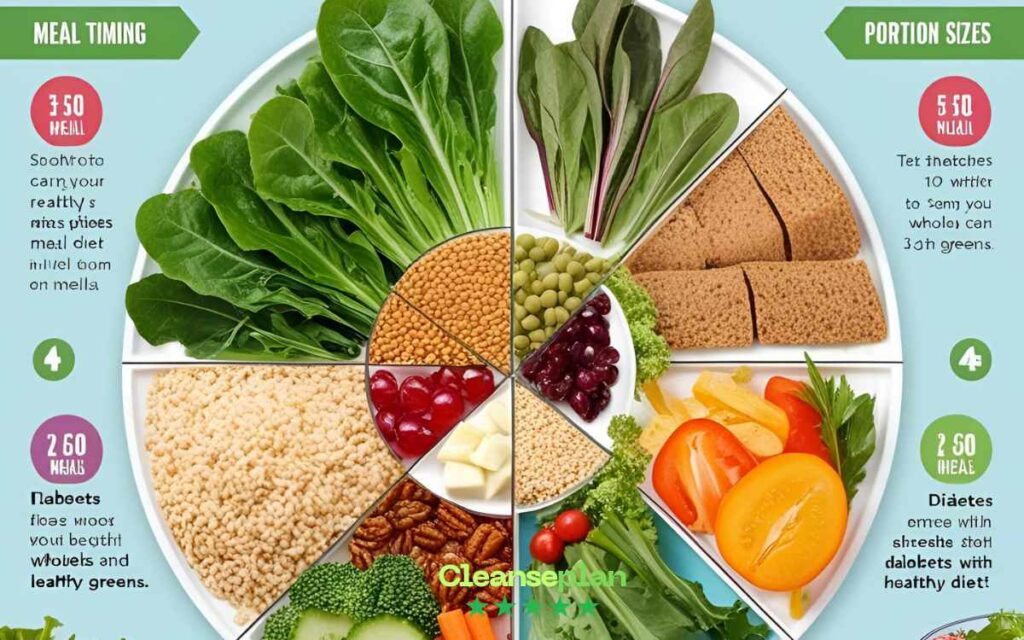Ultimate Diabetes Diet Plan: A Complete Guide to Healthy Living
Discover the ultimate diabetes diet plan tailored to support healthy blood sugar levels, weight management, and overall wellness. This complete guide offers practical meal planning tips, a day-wise diet chart, and expert-approved food choices to help you live a healthier, balanced life with diabetes.
Whether you’re newly diagnosed or managing your condition long-term, this plan provides sustainable nutrition strategies to improve your energy, reduce complications, and maintain optimal glucose control naturally.
Key Takeaways
Diabetes Diet Plan Chart (Sample – 1 Day)
| Meal | Food Items |
|---|---|
| Morning (7–8 AM) | Warm water with lemon + 5 soaked almonds |
| Breakfast (8:30 AM) | Vegetable oats porridge + 1 boiled egg or tofu slices |
| Mid-Morning Snack (11 AM) | A small apple or pear + green tea (no sugar) |
| Lunch (1 PM) | 1 multigrain roti + 1 cup mixed vegetable curry + salad + curd (low-fat) |
| Evening Snack (4 PM) | Roasted chana or sprouts salad + herbal tea |
| Dinner (7:30 PM) | Grilled fish/tofu + sautéed greens + ½ cup brown rice or quinoa |
| Bedtime (9:30 PM) | 1 cup warm turmeric milk (unsweetened, low-fat) |

Introduction to Diabetes and Diet
Understanding Diabetes: Types and Causes
Diabetes is a chronic medical condition marked by elevated blood sugar levels due to the body’s impaired ability to produce or utilize insulin, a hormone that regulates glucose.
Read Also: The Benefits Of A Raw Food Cleanse
There are three primary types of diabetes:
- Type 1 Diabetes: An autoimmune disorder where the immune system attacks insulin-producing beta cells in the pancreas, leading to little or no insulin production. It typically develops in childhood or adolescence and requires lifelong insulin therapy.
- Type 2 Diabetes: The most common form, characterized by insulin resistance, where cells fail to respond effectively to insulin, often compounded by inadequate insulin production over time. Risk factors include obesity, sedentary lifestyle, poor diet, and genetics.
- Gestational Diabetes: Develops during pregnancy, affecting how the body processes sugar. It usually resolves post-delivery but increases the risk of developing Type 2 diabetes later in life.
Other forms, such as monogenic diabetes or secondary diabetes (caused by conditions like pancreatitis), are less common.

Causes vary by type but include genetic predisposition, autoimmune triggers, lifestyle factors (e.g., high-calorie diets, physical inactivity), and hormonal changes during pregnancy.
Read Also: Nutritional Support During A Detox Cleanse
Importance of Diet in Managing Diabetes
Diet is a cornerstone of diabetes management, directly influencing blood sugar control, weight management, and overall health.
A well-structured diet can:
- Stabilize blood glucose levels, reducing dangerous spikes and dips.
- Lower the risk of complications, such as cardiovascular disease, kidney damage, and neuropathy.
- Improve insulin sensitivity, particularly in Type 2 diabetes.
- Support healthy weight loss or maintenance, critical for reducing insulin resistance.
By prioritizing nutrient-dense, low-glycemic foods and balancing macronutrients, individuals can achieve better glycemic control and enhance their quality of life.
Principles of a Diabetes-Friendly Diet
Carbohydrate Counting and Its Impact
Carbohydrates have the most significant impact on blood sugar because they break down into glucose during digestion.
Read Also: How To Unlock the Benefits of Alpilean’s Weight Support!
Carbohydrate counting is a practical strategy for managing glucose levels:
- How It Works: Track the grams of carbohydrates consumed per meal or day. A typical range is 45-60 grams per meal for adults, though this varies based on activity level, body size, and insulin use.
- Choosing Quality Carbs: Opt for complex carbohydrates (e.g., whole grains, legumes) over simple sugars (e.g., candy, soda), as they digest more slowly and cause gradual glucose increases.
- Tools for Success: Use food labels, nutrition apps, or portion guides to estimate carb intake accurately. For example, one slice of whole-grain bread contains about 15 grams of carbs, equivalent to a small apple.

Carb counting empowers individuals to make informed food choices and adjust insulin doses (for those on insulin therapy) to match carbohydrate intake.
Read Also: How to Easily Boost Your Fiber Intake with Metamucil?
The Role of Glycemic Index in Food Choices
The Glycemic Index (GI) ranks foods from 0 to 100 based on how quickly they raise blood sugar levels:
- Low-GI Foods (GI < 55): Examples include lentils, non-starchy vegetables, and most fruits (e.g., apples, berries). These cause slow, steady glucose rises.
- Medium-GI Foods (GI 56-69): Include whole-grain bread and brown rice, suitable in moderation.
- High-GI Foods (GI > 70): White bread, sugary cereals, and processed snacks cause rapid glucose spikes and should be limited.
The Glycemic Load (GL), which considers both GI and portion size, is also useful.
For instance, watermelon has a high GI but a low GL due to its low carb content per serving. Prioritizing low- to medium-GI foods helps maintain stable blood sugar and reduces the need for large insulin corrections.
Balancing Macronutrients for Stable Blood Sugar
A balanced diabetes diet incorporates carbohydrates, proteins, and fats in appropriate proportions:
- Carbohydrates (45-65% of daily calories): Choose fiber-rich, low-GI sources like oats, quinoa, and vegetables to slow glucose absorption.
- Proteins (15-20% of daily calories): Lean proteins (e.g., chicken breast, fish, tofu, eggs) support muscle health and satiety without significantly affecting blood sugar.
- Fats (20-35% of daily calories): Focus on unsaturated fats from avocados, nuts, seeds, and olive oil, which promote heart health—a priority for diabetics at higher risk of cardiovascular issues.
A practical approach is the plate method: fill half your plate with non-starchy vegetables (e.g., broccoli, spinach), one-quarter with lean protein, and one-quarter with whole grains or starchy vegetables.
This ensures balanced nutrition and portion control.
Best Foods for a Diabetes Diet
Top 10 Superfoods for Diabetics
Incorporating nutrient-dense foods can optimize diabetes management.

Here are ten superfoods with specific benefits:
- Berries (Blueberries, Strawberries): Low in sugar, high in antioxidants, and fiber, reducing inflammation and oxidative stress.
- Leafy Greens (Spinach, Kale): Packed with vitamins A, C, and K, and low in carbs, making them ideal for blood sugar control.
- Nuts (Almonds, Walnuts): Provide healthy fats, protein, and fiber, promoting satiety and heart health.
- Fatty Fish (Salmon, Mackerel): Rich in omega-3 fatty acids, which reduce inflammation and improve cardiovascular health.
- Greek Yogurt (Unsweetened): High in protein and probiotics, low in carbs, supporting gut health and blood sugar stability.
- Chia Seeds: High in fiber, omega-3s, and calcium, slowing digestion and stabilizing glucose levels.
- Broccoli: A low-carb, high-fiber vegetable rich in chromium, which may enhance insulin function.
- Quinoa: A low-GI, nutrient-dense grain high in protein and fiber, suitable for replacing refined grains.
- Cinnamon: Contains compounds that may improve insulin sensitivity; sprinkle on oatmeal or yogurt.
- Legumes (Lentils, Chickpeas): High in fiber, protein, and complex carbs, promoting steady blood sugar levels.
Best Fruits and Vegetables for Blood Sugar Control
Not all fruits and vegetables are equal for diabetes management:
- Fruits: Choose low-GI options like berries, apples, pears, and citrus fruits (oranges, grapefruit). These are high in fiber and antioxidants, which slow sugar absorption. Limit high-sugar fruits like bananas, mangoes, and grapes, and pair them with protein or fat (e.g., apple with almond butter) to reduce glycemic impact.
- Vegetables: Prioritize non-starchy vegetables such as zucchini, cauliflower, bell peppers, and leafy greens, which are low in carbs and high in nutrients. Limit starchy vegetables like potatoes, corn, and peas, and control portions when including them.
Aim for 4-5 servings of vegetables and 2-3 servings of fruit daily, spread across meals to avoid glucose spikes.
Whole Grains and Fiber-Rich Foods
Dietary fiber, particularly soluble fiber, slows glucose absorption and improves insulin sensitivity:
- Whole Grains: Opt for brown rice, barley, farro, or whole-grain pasta over refined grains. For example, ½ cup of cooked quinoa provides 20 grams of carbs and 2.5 grams of fiber.
- Other Fiber Sources: Include beans, lentils, avocados, chia seeds, and bran cereals. Soluble fiber in oats and apples forms a gel-like substance in the gut, reducing glucose spikes.
- Daily Goal: Aim for 25-30 grams of fiber daily, achievable by incorporating a variety of plant-based foods.
Fiber also promotes satiety, aiding weight management—a key factor in Type 2 diabetes control.
Foods to Avoid in a Diabetes Diet
High-Glycemic Foods and Hidden Sugars
Foods that rapidly elevate blood sugar should be minimized:
- Sugary Beverages: Soda, sweetened tea, energy drinks, and fruit juices deliver concentrated sugar with no fiber to slow absorption.
- Refined Grains: White bread, white rice, and sugary cereals have high GI values and minimal nutritional value.
- Sweets and Desserts: Cakes, cookies, and candies cause sharp glucose spikes and contribute to weight gain.
- Hidden Sugars: Check labels for added sugars in seemingly healthy foods like yogurt, granola bars, sauces, and salad dressings. Ingredients like high-fructose corn syrup, maltose, or dextrose indicate hidden sugars.
When cravings strike, opt for naturally sweet, low-GI alternatives like berries or a small square of dark chocolate (70% cocoa or higher).
Processed Foods and Their Impact on Blood Sugar
Processed foods are often high in refined carbs, unhealthy fats, and sodium, exacerbating insulin resistance and weight gain:
- Fast Food: Burgers, fries, and pizza are typically high in trans fats and refined carbs, leading to poor glycemic control.
- Packaged Snacks: Chips, crackers, and microwave popcorn often contain hidden sugars and unhealthy oils.
- Frozen and Canned Meals: Many are high in sodium and preservatives, which can contribute to hypertension—a common diabetes comorbidity.
Choose whole, minimally processed foods like fresh vegetables, lean meats, and home-cooked grains to maintain nutrient density and avoid harmful additives.
Creating a Daily Diabetes Meal Plan
Sample Meal Plan for a Day
This sample plan is designed for an average adult with diabetes, providing approximately 80-90 grams of carbs daily (adjustable based on individual needs):
- Breakfast (15g carbs): ¾ cup unsweetened Greek yogurt with ½ cup mixed berries and 1 tbsp chia seeds. Pair with black coffee or herbal tea.
- Morning Snack (10g carbs): 10 raw almonds and a small apple (about 100g).
- Lunch (30g carbs): Grilled chicken breast (4 oz) on a mixed green salad (spinach, cucumber, cherry tomatoes) with 1 tbsp olive oil and balsamic vinegar dressing; ½ cup cooked quinoa.
- Afternoon Snack (8g carbs): 1 cup carrot sticks with 2 tbsp hummus.
- Dinner (25g carbs): 5 oz baked salmon with 1 cup steamed broccoli and ½ cup brown rice, seasoned with lemon and herbs.
Total: ~88g carbs, 70g protein, 50g fat (approximate). Consult a dietitian to tailor carb and calorie goals to your specific needs, especially if using insulin.
Breakfast, Lunch, Dinner, and Snack Options
Variety prevents dietary monotony and ensures nutrient diversity:
- Breakfast:
- Overnight oats (⅓ cup oats, almond milk, cinnamon, 1 tbsp walnuts).
- Veggie omelet (2 eggs, spinach, mushrooms) with 1 slice whole-grain toast.
- Smoothie with ½ cup berries, 1 cup unsweetened almond milk, and 1 tbsp flaxseeds.
- Lunch:
- Turkey and avocado wrap (whole-grain tortilla, 3 oz turkey, ¼ avocado, lettuce).
- Lentil soup (1 cup) with a side salad and 1 tbsp olive oil dressing.
- Grilled shrimp (4 oz) over zucchini noodles with marinara sauce.
- Dinner:
- Baked cod (5 oz) with 1 cup roasted Brussels sprouts and ½ cup farro.
- Stir-fried tofu with mixed vegetables (bell peppers, broccoli) and ½ cup brown rice.
- Lean beef (4 oz) with 1 cup sautéed green beans and ½ cup mashed sweet potato.
- Snacks:
- 1 oz string cheese with ½ cup cherry tomatoes.
- 1 tbsp almond butter with celery sticks.
- ½ cup edamame sprinkled with sea salt.
Tips for Portion Control and Meal Timing
Proper portioning and timing enhance glycemic control:
- Portion Control: Use smaller plates (9-inch diameter) to visually manage portions. Measure foods initially (e.g., with a food scale or measuring cups) to learn appropriate serving sizes. For example, ½ cup cooked rice is roughly the size of a fist.
- Meal Timing: Eat every 3-4 hours to maintain steady blood sugar. Aim for three meals and 1-2 snacks daily, avoiding long gaps that can lead to hypoglycemia or overeating.
- Balancing Meals: Pair carbs with protein or fat to slow digestion. For instance, eating an orange with a handful of nuts reduces its glycemic impact compared to eating it alone.
Consistency in meal timing also supports insulin therapy and reduces cravings.
Lifestyle Changes to Support a Diabetes Diet
The Role of Exercise and Hydration
Exercise: Physical activity improves insulin sensitivity, lowers blood sugar, and supports weight management. Aim for:
- 150 minutes of moderate aerobic exercise weekly (e.g., brisk walking, cycling, swimming).
- Strength training 2-3 times per week (e.g., bodyweight exercises or light weights) to build muscle, which enhances glucose uptake.
- Start slowly if new to exercise, and monitor blood sugar before and after workouts to prevent hypoglycemia.
Hydration: Drink 8-10 cups (64-80 oz) of water daily to support metabolism and kidney function. Dehydration can elevate blood sugar, so avoid sugary drinks and limit caffeine, which can act as a diuretic.
Stress Management and Its Effect on Diet
Chronic stress raises cortisol and adrenaline, hormones that increase blood sugar and trigger cravings for high-carb foods:
- Mindfulness Practices: Try meditation, deep breathing, or progressive muscle relaxation for 10-15 minutes daily to reduce stress.
- Yoga: Combines physical movement with relaxation, improving both stress and glucose control.
- Sleep: Aim for 7-8 hours of quality sleep nightly. Poor sleep disrupts hunger hormones (ghrelin and leptin), leading to overeating and insulin resistance.
Stress management complements dietary efforts, creating a holistic approach to diabetes care.
Supplements and Natural Remedies
Essential Vitamins and Minerals for Diabetics
Certain nutrients support diabetes management, but deficiencies are common due to altered metabolism or medication side effects:
- Vitamin D: Enhances insulin sensitivity and reduces inflammation. Sources include fortified foods, fatty fish, or supplements (consult a doctor for dosing, often 1,000-2,000 IU daily).
- Magnesium: Regulates glucose metabolism and supports nerve health. Found in nuts, seeds, leafy greens, and whole grains; supplements (200-400 mg daily) may be needed if deficient.
- Chromium: May improve insulin action. Found in broccoli, whole grains, and lean meats; supplements (200-1,000 mcg daily) should be taken under medical supervision.
Always verify nutrient needs with blood tests and consult a healthcare provider before supplementing.
Herbs and Natural Supplements That Help
Some herbs and supplements show promise in supporting blood sugar control, but evidence varies, and interactions with medications are possible:
- Cinnamon: Contains polyphenols that may lower fasting blood sugar and improve insulin sensitivity. Use ½-1 tsp daily in food or as a supplement (capsules, 500 mg).
- Fenugreek: Seeds are high in soluble fiber, potentially improving glucose tolerance. Try 2-5 grams daily (as seeds or capsules), but consult a doctor, as it may interact with medications.
- Bitter Melon: Contains compounds that mimic insulin. Available as tea, juice, or capsules; typical doses are 50-100 mL juice or 1-2 g capsules daily.
- Alpha-Lipoic Acid (ALA): An antioxidant that may reduce oxidative stress and improve insulin sensitivity. Typical doses are 300-600 mg daily.
Caution: Herbal supplements can interact with diabetes medications, causing hypoglycemia or other side effects. Always consult a healthcare provider before use, and avoid replacing prescribed treatments with supplements.


![Seaweeds, Algae & Gut Microbes Nourishing Your Body Naturally[1]](https://mycleanseplan.com/wp-content/uploads/2025/10/Seaweeds_Algae__Gut_Microbes__Nourishing_Your_Body_Naturally1-768x448.jpg)

![Should You Avoid FODMAPs Forever Unpacking the Diet's Truth[1]](https://mycleanseplan.com/wp-content/uploads/2025/11/Should_You_Avoid_FODMAPs_Forever__Unpacking_the_Diets_Truth1-768x448.jpg)

